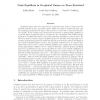Free Online Productivity Tools
i2Speak
i2Symbol
i2OCR
iTex2Img
iWeb2Print
iWeb2Shot
i2Type
iPdf2Split
iPdf2Merge
i2Bopomofo
i2Arabic
i2Style
i2Image
i2PDF
iLatex2Rtf
Sci2ools
102
Voted
SIGECOM
2006
ACM
2006
ACM
Nash equilibria in graphical games on trees revisited
Graphical games have been proposed as a game-theoretic model of large-scale distributed networks of non-cooperative agents. When the number of players is large, and the underlying graph has low degree, they provide a concise way to represent the players’ payoffs. It has recently been shown that the problem of finding Nash equilibria on a general degree-3 graphical game is complete for the complexity class PPAD, indicating that it is unlikely that there is any polynomial-time algorithm for this problem. We show here that in contrast, degree-2 graphical games are tractable. Our algorithm uses a dynamic-programming approach, which was introduced by Kearns, Littman and Singh in the context of graphical games on trees. The algorithm of Kearns et al. is a generic algorithm which can be used to compute all Nash equilibria. The running time is exponential, though approximate equilibria can be computed efficiently. Littman, Kearns and Singh proposed a modification to the generic algorithm...
Related Content
| Added | 14 Jun 2010 |
| Updated | 14 Jun 2010 |
| Type | Conference |
| Year | 2006 |
| Where | SIGECOM |
| Authors | Edith Elkind, Leslie Ann Goldberg, Paul W. Goldberg |
Comments (0)

